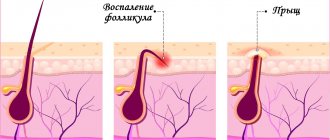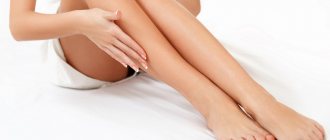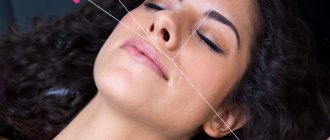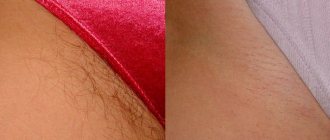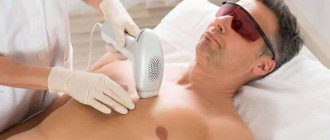Ingrown hairs after waxing are a common problem that girls face after using waxes. Ingrown hairs after hair removal can be prevented if you take all measures aimed at solving this problem. Various methods and means are used against ingrown hairs, for example, peeling, scrub, milk, and even better, go for a consultation with a cosmetologist, since another skin disease may be hidden behind an ingrown hair. Today we will talk about remedies for ingrown hairs after depilation. Read the following article on the pages of the magazine.
Ingrown hair
The consequence of an incorrectly carried out procedure for removing hair from the skin (shaving, depilation or epilation) is hairs ingrown under the top layer of the skin. This is not only an aesthetically unpleasant moment in the post-epilation period, but also threatens the appearance of pustules, ulcers and hyperpigmented scars.
The consequence of an incorrectly carried out procedure for removing hair from the skin is hairs ingrown under the top layer of the skin.
The growing hair follows the simplest path of least resistance and bends, which leads to its improper growth, namely, when removing hair by depilation (or shaving), the upper layer of the epidermis is damaged, resulting in the formation of a micro-wound on the surface of the skin. Over time, the wound heals, and natural restoration of the epidermis occurs on its surface.
The hair, whose growth is activated, is looking for a way out, but the too hard and dense layer of the epidermis does not allow it to “break through”, which is why it continues to grow not in the vertical direction, but horizontally. The reasons may be individual characteristics of the skin (dense epidermal layer of skin), hormonal changes, synthetic underwear, under which the skin does not breathe and sweats.
Why does hair grow ingrown?
The cause of this problem may be various factors. Some people are predisposed to ingrown hairs on certain parts of the body. People with dark skin and coarse hair are more prone to this problem. People with fair skin and soft hair type are less prone to this.
Often, ingrown hairs occur after home hair removal, however, this often happens after salon hair removal. To properly deal with a problem, you must determine the cause of its occurrence. Cosmetology specialists have noticed that ingrowth is often associated with the number of balls of the scaly layer of the epidermis, as well as its density.
If there are a lot of such balls, this leads to a denser structure; it is difficult for the skin and new vegetation to overcome this layer. Therefore, hairs can bend during growth and grow not upward, but horizontally into the skin. The problem is more common in dark-skinned people with coarse hair because coarse hair grows more rapidly than light, soft hair. At the same time, one should also take into account the increased density of dark skin, through which it is difficult for vegetation to penetrate. So why do hair grow ingrown?
The reasons that provoke the process of ingrowth include:
- Dense layer of epidermis.
- Changes in hormonal balance during the first half of the menstrual cycle, when there is a sharp increase in estrogen. The same changes are possible when the functions of the endocrine system are disrupted with an increase in estrogen levels.
- Injury to the hair canal during hair removal, which causes a microscopic scar to appear in the canal.
- Hair breaking off inside the skin, which occurs when epilation is performed incorrectly.
- Shaving with a machine, which is carried out against the direction of the hair, especially using a dull blade.
- Using too tight underwear made of synthetic fabric immediately after hair removal. This type of underwear traps moisture on the skin and can promote bacterial infections. Therefore, it is not recommended to wear synthetic underwear for the first time after the hair removal procedure, because this can provoke the development of an inflammatory process at the site of the ingrown hair.
Against ingrown hairs
To remove ingrown hairs, it is recommended to use special gels and under no circumstances use a scrub, especially if pustular formations appear on the skin. In such situations, it is worth using Chlorhexidine 2 times a day.
If there are a lot of pustules on the skin, do not self-medicate
If there are a lot of pustules on the skin, do not self-medicate! Ingrown hairs can easily be confused with a skin condition such as herpes. If severe inflammation occurs, it is better to consult a dermatovenerologist: only a qualified doctor can correctly diagnose the problem.
When home treatment for ingrown hairs after depilation does not bring results, you should make an appointment at a cosmetology clinic, whose specialists will be able to choose the best solution to the problem.
It is recommended against ox ingrowth:
- do light peeling to remove dead cells from the surface of the skin before direct hair removal;
- using moisturizer, lotion, skin milk (but not oil), as well as special products that slow down hair growth;
- do regular peeling (2 times a week) to cleanse pores using a salt scrub that has an antiseptic effect;
- treat delicate areas of the skin with chlorhexidine or salicylic acid solution to prevent inflammation.
Symptom Description
Ingrown hairs are those that develop under the surface of the skin without coming out. This phenomenon is most often observed after various methods of depilation, including sugaring and waxing; it can rarely be detected after shaving. Owners of coarse, dark, curly hair are more predisposed to this cosmetic problem. This phenomenon may be accompanied by the formation of pustules or papules on the skin, and often hyperpigmentation also occurs. Find out what is better: sugaring or waxing in this material.
The site of the ingrown hair can be painful and often swells.
It should be remembered that from a medical point of view, such hairs are practically harmless. Therefore, this phenomenon is most often considered as a cosmetic problem.
The reasons for ingrown hairs after depilation at home or in a salon are very diverse. These include:
- Microtraumas. They often occur due to non-compliance with waxing or sugaring technology.
- Incorrect depilation procedure. Excessive stretching of the skin during sugaring and other methods.
- Improper skin care and frequent scrubbing. Normally, it should be done once a week.
- Hormonal surges. In women, they are often observed in the second phase of the menstrual cycle.
In some cases, ingrown hairs into the skin can be caused by shaving. This happens if the hair cut is very close to the skin. During growth, the hair shaft bends and re-enters the skin.
Ingrown hair epilation
The process of ingrown hair depends on the density of the epidermis, that is, on the number of layers of scales. If there are many of them, then it is difficult for a thin growing hair to break through to the surface of the skin, and it chooses the path of least resistance, bending and taking not a vertical, but a horizontal position.
People with dark skin develop ingrown hairs after hair removal more often than people with light skin. This is due to the fact that dark and coarse hairs grow more intensively than light and thin ones. Solving the problem on your own can only worsen the condition of the skin, so to treat ingrown hairs after depilation, you need to contact a professional cosmetologist.
If there is no inflammation and the hairs are located shallow, it is enough to steam the skin and then do a light gentle peeling
Hair prevention after hair removal
If there is no inflammation and the hairs are located shallowly, it is enough to steam the skin and then do a light, gentle peeling. Sometimes, instead of a scrub, a not very hard washcloth or a special mitten made of synthetic material is used. After the procedure, the skin is softened with lotion or moisturizer.
The deep location of the hairs can be immediately noticed by slight redness and thickening of the skin. In such cases, you cannot do without the help of tweezers and a medical needle. The specialist steams the area where hair grows in after depilation with a warm, damp compress, and disinfects the surface with an antiseptic.
Then, use a sterile needle to pry up the hair and remove it with tweezers. The treated area is once again treated with an antiseptic, and a cooling compress is applied to it. If inflammation is present, it is recommended to apply an anti-acne product for several days before going to the cosmetologist.
Causes of ingrown hairs after hair removal
To get rid of ingrown hairs after depilation, you need to establish the reason why it occurred. Removing excess vegetation on the skin in a beauty salon does not always make it possible to avoid such situations. Dermatologists and cosmetologists see a relationship between ingrown hairs after depilation and the thickness of the skin. With a high density of the epidermis and a large number of its structural cells, the skin becomes coarser, which makes it difficult for the growing hair to move through it. This causes the hair to bend and begin to grow in the opposite direction.
In brunettes with dark skin, hairs grow in more often after depilation compared to people with fair skin. This is due to the anatomical features of the structure of dark skin, which determine the higher density of its epidermal layer.
The reasons for situations where hair begins to grow incorrectly after removal include:
- Violation of the hair removal algorithm. In this case, ingrown hairs occur due to a violation of the integrity of the skin and the formation of microscopic damage in the follicular canal. Also, after removal, hairs grow in as a result of their breaking below the level of the epidermis.
- Increased density of the epidermal layer. The coarsening of the upper layer of the skin is caused by the use of incorrectly selected cosmetics, when the cream used is not suitable for the skin type.
- A change in the level of hormones in the vascular bed, which is pathological in nature - when the functioning of the endocrine system is disrupted, or occurs as a result of physiological processes - premenstrual or menopausal periods.
- Ingrown hairs after depilation occur with frequent shaving . If an interval of 2-3 days is not observed between procedures, this leads to thinning of the hair structure, which makes it difficult for it to move through the epidermal layers of the skin.
- Hairs grow in when shaving rules and techniques are violated - when shaving hair against its growth or after using non-sharp razor blades.
- Wearing tight-fitting clothing made from artificial materials.
When a person knows why hair grows, he is able to avoid complications after hair removal.
If there are not many ingrown hairs, you can remove them with tweezers one at a time.
Ingrown hairs after epilation
Ingrown hairs after epilation cause a lot of discomfort. If epilation is carried out incorrectly, the hair changes the direction of its growth and, as a result, cannot grow out from under the skin. Ingrowth can be superficial or deep.
In the first case, there is no severe inflammation, and after treatment the hair pustule breaks out on its own. In the second, a fairly large compaction is formed. After it dries, a crust appears, but the bristles remain invisible, and surgical intervention is often required.
If precautions have not helped prevent ingrown hairs, then you need to help them break out. If you have ingrown hairs, it is not recommended to use fatty oils to moisturize the skin. There are several methods available to every woman, using which you can eliminate the problem of ingrown hairs after hair removal.
There are several methods available to every woman that can be used to eliminate the problem of ingrown hairs after hair removal.
Using salicylic acid against ingrown hairs
It has different release forms, is affordable, and has a pronounced antiseptic effect. Therefore, if irritation appears at the site of an ingrown hair, you need to lubricate it three times a day and after a few days the redness will go away.
Using a sterile needle against ingrown hairs
Using a needle, you can remove the ingrown hair from under the skin. The needle should be taken not from a sewing needle, but from a medical one, which is opened immediately before use. After the procedure it is thrown away. One needle cannot open different wounds, one hair - one needle. This is done in order to avoid infection.
Using a hard washcloth against ingrown hairs
If the hair is not very ingrown and only causes itching, then you can take a hard washcloth and walk over it. This will lift the ends of the hairs and give them proper growth.
Often, when an ingrowth occurs, purulent pimples form that need to be opened; to do this, you need to wash your hands, disinfect the area with chlorhexidine and open the abscess. We wipe off the resulting exudate with a cotton pad, also pre-treated with a chlorhexidine solution, and lubricate it with an antiseptic or healing ointment.
Treatment methods
There are various ways to effectively remove ingrown hairs. There are many folk remedies, medications, as well as hardware techniques that allow you to cope with this problem. They need to be considered in more detail. Find out how thread depilation works here.
Medications
The use of certain drugs allows you to quickly soften the skin and promote hair growth to the surface. These drugs can rightly include:
- Salicylic acid. The product is applied to damaged skin areas once or twice a day. Allows you not only to solve the problem of ingrown hair, but also to prevent infection from entering the follicle.
- Herbal lotions. They are made from chamomile or calendula. The products have a mild soothing effect and help relieve skin irritation.
- Special lotion. To prepare it, take a quarter glass of boiled water, a teaspoon of glycerin and two aspirin tablets. All this is mixed and applied to the problem area of the skin twice a day. Creams that slow down hair growth also work well.
Special lotion for ingrown hairs.
You can also use various ready-made creams to remove ingrown hairs, for example, the product from Folisan. They not only effectively deal with existing ingrown hairs, but also prevent the appearance of new ones.
If the presented medications do not help, the ingrown hair will need to be mechanically removed. This can be done at home, but it is better to consult a specialist. This will reduce the risk of scarring and pigmentation, which often occurs when this procedure is performed incorrectly. You can learn about the features of choosing a depilatory cream in the article.
Folk
At home, it is recommended to remove ingrown hairs mechanically. This should be done with a clean needle or tweezers:
- First you need to wipe the skin at the site where the tubercle appears with alcohol or peroxide. This will prevent infection from getting inside.
- The tool you will be working with should also be disinfected. Under no circumstances should you use ordinary sewing needles or pins, which you recently used for their intended purpose, for such purposes. It's better to get a new tool.
- If you are using tweezers, you need to gently press on the tubercle so that the hair comes out. You will need to grab the tip of the hair and pull the entire hair out completely. If you are working with a needle, you will need to pierce the skin and pry up the hair. There is no need to go deep into the dermis. Deeply ingrown hair cannot be removed at home.
- After this, the wound will need to be treated with a chlorhexidine solution. If you don't have it on hand, you can use hydrogen peroxide.
You can remove ingrown hairs using tweezers.
If a large amount of pus has formed in the hair follicle, you cannot open it at home - this can lead to tissue infection. If such a problem occurs, it is better to contact a cosmetologist at the salon. The specialist will open the tubercle using a scalpel and ensure proper antiseptic treatment of the wound.
Hardware cosmetology
In beauty salons and beauty salons, you can get rid of ingrown hairs using various hardware techniques. Among them:
- Laser removal. Suitable for girls with dark hair and fair skin. This technique involves the gradual destruction of the follicle under the influence of a laser of a certain length. The laser hair removal procedure allows you not only to get rid of existing ingrown hairs, but also to prevent their occurrence.
Laser removal of ingrown hairs.
- Electrolysis. In this method, the doctor pierces the capsule with the ingrown hair and applies high voltage to it. Due to this, the hair root is destroyed, and then the remains of its structure. This technique is used less frequently because it can cause burns on the skin. It's also worth finding out what enzyme hair removal is here.
- Thermolysis. This procedure is similar to the previous one, but instead of high voltage, here a high-frequency current is supplied to the tool. Like electrolysis, this technique is associated with various side effects, including hyperpigmentation. Find out when numbing creams are needed during hair removal by following this link.
Thermolysis for ingrown hairs.
- Phototherapy. Provides hair removal using a light beam of a certain length. Photoepilation is simple, absolutely painless and can be used on various parts of the body. More suitable for dark than light hair.
Before using any of the above hardware techniques, you must consult a doctor and undergo an examination. The specialist must determine whether you have contraindications to such treatment, or whether it can be safely carried out.
Ingrown hair remedy
Cosmetic and pharmaceutical brands produce a wide range of products against ingrown hairs in various price categories.
Anti-ingrown hair lotion Depilflax
The lotion is suitable for all skin types, including problematic and sensitive. The active ingredient is salicylic acid. It gently exfoliates the top layer, making the cover very soft. Thanks to this, the hair grows in the right direction and easily penetrates to the top.
Anti-ingrown hair lotion with lemon Aravia Professional
The lotion prevents the formation of ingrown hairs after depilation, soothes and relieves irritation. It has a mild disinfectant property, so it does not cause dryness and flaking. The product is suitable for any skin type and all areas of the body. It does not contain synthetic fragrances, sulfates, alcohol, or parabens.
Cosmetic and pharmaceutical brands produce a wide range of products against ingrown hairs in various price categories
Cristaline Anti-Ingrown Hair Gel for Delicate Areas
The gel prevents ingrown hairs and is an excellent after-depilation care product. The gel texture slightly cools, tones, and relieves all painful symptoms. If there are already inflammatory formations, then the remedy will eliminate swelling and speed up the healing of small pustules and large dense boils. Using the product leads to the restoration of natural internal processes and a clear improvement in appearance. The cover looks healthy, smooth, uniform in color.
Anti-ingrown hair product Waxellent GARDENS Irisk Professional
The domestic brand uses plant extracts and oils that are collected in the most environmentally friendly regions of the country. Constant use leads to smoothing of the skin, improving the internal and external condition of the skin. The increased concentration of active components enhances metabolic processes and normalizes hydro-lipid balance. Buyers gave the Irisk Professional product high marks for efficiency, economical consumption, and ease of use.
Sources:
- https://elenis.com.ua/polezno/114-vrastanie-voloso
- https://depilux.ru/stati/vrastayut-volosy-posle-depilyatsii.html
- https://expertology.ru/15-luchshikh-sredstv-protiv-vrosshikh-volos/
- https://v-kurse.ru/news/health/problema_vrosshikh_volos_posle_epilyatsii_8835990/
Post Views: 40
Methods to combat ingrown hairs
To remove ingrown hairs, you don’t have to seek help from a beauty salon; you can get rid of them at home. You can combat the problem of ingrown hairs into the epidermal layer in the following ways:
- In the case of a superficial location of the deformed hair, you can get rid of it by removing the keratinized layer of the epidermis using peels or a hard glove. Initially, the skin must be steamed, and after the procedure, a moisturizing cream or body milk is applied to it.
- The presence of pustules on the surface of the skin is a contraindication to the use of scrubs and peels. An ointment such as Levomekol, which is applied to the affected areas of the skin several times a day, helps fight inflammation. After 1-1.5 days, the inflammation goes away and you can try to get rid of ingrown hairs with peeling.
- If removing ingrown hairs using peeling is ineffective, they are removed with disinfected tweezers. Alcohol solutions are used for disinfection.
More details about ingrown hair removal are described in this article.
Inflammation is controlled with antiseptic agents.
If ingrown hairs are accompanied by a strong inflammatory process with the formation of purulent foci, their removal occurs surgically in a medical institution. The surgeon opens the area of suppuration, cleanses its cavity from pathological contents, removes hair and applies an antiseptic bandage.
In some cases, the doctor prescribes a course of treatment with antibacterial drugs or the use of retinoids and corticosteroids.
You can fight ingrown hairs using hardware techniques only in beauty salons. These methods of eliminating the problem are based on exposing the hair to flashes of light or a laser beam, as a result of which its structure is destroyed.
Video: experience in dealing with ingrown hairs.
